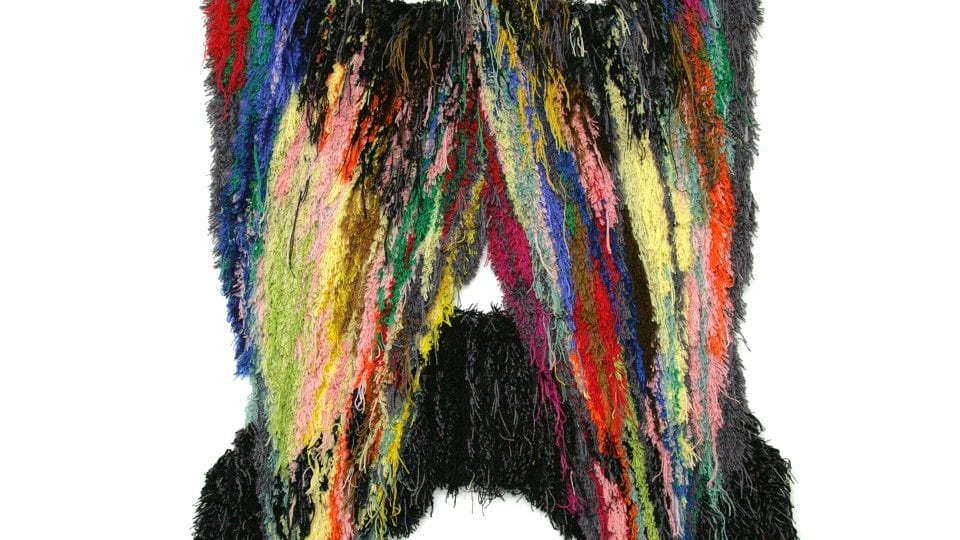Caroline Achaintre (b. 1969) works across a diverse range of media that includes textiles, ceramics, prints and watercolours, using techniques typically associated with the applied arts. Opening a new exhibition at Baltic, Gateshead, Aesthetica talk to the artist about her influences, labour-intensive practice and bold contributions to the arts industry.
A: Your work seems to draw up many interesting parallels, for example between ancient and modern, or geometric minimalism in contrast with technology. Could you talk about how these dichotomies have informed your practice, in both conceiving ideas and in their execution
CA: My inspiration comes from ethnological collections just as much as popular culture, especially the aesthetics of music, album covers, or for example handbags, their surfaces and the faces I see in them. Those influences coexist with each other, but they also relate to each other. Geometry, Primitivism, Anthropomorphism, Futurism, Science Fiction, it is all connected.
A: How do you feel that you relate personally to the works? They seem to enact striking tribal masks; do you feel as an artist that you must be able to see part of yourself in the artwork or can it be devoid from your personal background/context as a work in its own right?
CA: The work is always personal, even if it does not necessarily talk from one’s direct background. I create my own world in a way, characters that coexist with each other, sometimes within one piece. I am interested in the idea of looking in and out simultaneously, which often results in mask-like pieces. It is a fusion of the mask and the bearer of it, they are both real. There is more than one persona within one being. Within the world I create there are certainly aspects of my own persona, but in not such a literal way.
A: Many of your pieces seem to be labour intensive, requiring technicality and perseverance. Could you talk about the actual processes involved?
CA: My wall hangings are hand-tufted, the process is very physical, but less labour intensive as for example weaving. I use an air tool connected to a compressor and with air pressure I shoot wool from the back through the canvas. It’s an additive way of working, I shoot one line of wool into the canvas and it immediately expands, so I have a line. It’s kind of a three-dimensional woollen painting. My ceramic sculptures are made in a more spontaneous way; I try to capture expressions in clay, which has to happen fast.
A: How important do you think other artists and contextual influences are on your practice?
CA: Well, there are a range of artists I admire, such as Mike Kelley, Rosemarie Trockel, Kai Althoff, Carol Rama just to name a few, but there are no direct references.
A: Could you talk about the influences in your work, perhaps commenting on the references to German Expressionism, “Primitivism” and post-war British sculpture?
CA: I can relate to the directness of Expressionism, the dark side within it, the portrayal of ‘angst’. Especially when I was working intensely with linocuts I looked a lot at Emil Nolde’s work.
A: How do you think that colour contributes to the reception of the works? Is the choice of colour something that you consider within the initial ideas for the art?
CA: Colour is an important part of my work, it sets the tone for the world/character the piece is from, often bright, but sometimes also muted and subtle. Again, I play with associations, also through colour. The tufted piece Ray-Inn radiates sun rays, whereas the ceramic sculpture ‘Mola’ looks like it comes from the bottom of the sea.
A: What is it about texture that you find so interesting as an element to consider? How do you think your audiences respond to the sensual aspect of the sculptures?
CA: I want my pieces to be non-neutral. Texture supports that, as it can emulate surfaces such as skin and fur. My shaggy wool hangings certainly have an eerie feeling to them, often they look like fur or hair and have an animist quality. Wool has an aura, although I am not into New Age, it really has. Those wall hangings are very intense, they have such a strong physical presence. My clay sculptures operate on a more seductive level, its luscious glazes can be very seductive. I like emulating surfaces, such as snake or fish skin and in conjunction with its shininess the ceramics seem moist and alive.
A: If your works collectively had a specific tone, what do you think that would be?
CA: Intense and playful.
Opens today until 30 October. For more information: www.balticmill.com
Credits:
1. Caroline Achaintre Moustache–Eagle (2008). Courtesy of BALTIC.





